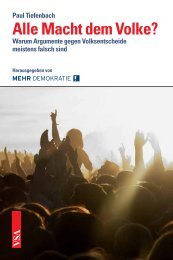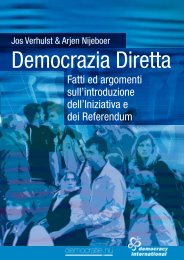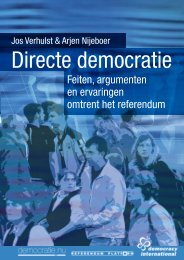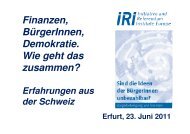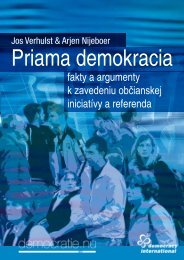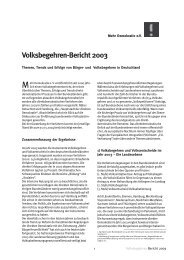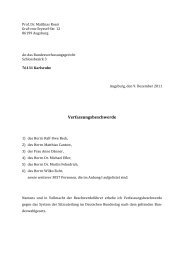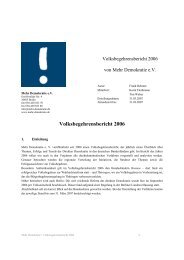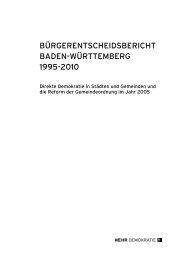Facts and Arguments about the Introduction of Initiative and ...
Facts and Arguments about the Introduction of Initiative and ...
Facts and Arguments about the Introduction of Initiative and ...
Create successful ePaper yourself
Turn your PDF publications into a flip-book with our unique Google optimized e-Paper software.
as coinciding with <strong>the</strong> communal interest in <strong>the</strong> long term.<br />
The opposite <strong>of</strong> ‘civicness’ is ‘amoral familialism’. Someone<br />
with this latter attitude is only concerned with <strong>the</strong> short-term<br />
interests <strong>of</strong> <strong>the</strong> narrow family circle. A society in which this<br />
short-term familial focus predominates is atomised. The<br />
communal interest is left to those in power, which means that<br />
mainly opportunistic relationships are formed (clientelism).<br />
In order to measure ‘civicness’, Putnam used an index based<br />
on <strong>the</strong> following indicators:<br />
• <strong>the</strong> percentage <strong>of</strong> votes which are not cast for <strong>the</strong> leading<br />
c<strong>and</strong>idate in an election: in a society in which amoral familialism<br />
predominates, <strong>the</strong>re is generally a higher proportion<br />
<strong>of</strong> such votes (electoral clientelism);<br />
• voter turnout in referendums: because direct clientelism<br />
cannot play a role in referendums, <strong>the</strong> level <strong>of</strong> participation<br />
in direct-democratic decision-making is a good indicator <strong>of</strong><br />
‘civicness’;<br />
• <strong>the</strong> number <strong>of</strong> newspaper readers: reading newspapers indicates<br />
interest in society as a whole;<br />
• <strong>the</strong> level <strong>of</strong> participation in social life (such as clubs etc):<br />
taking part in social life broadens horizons beyond <strong>the</strong> core<br />
family.<br />
Putnam (1993, p. 97-98) characterised <strong>the</strong> difference between<br />
<strong>the</strong> two sorts <strong>of</strong> society he discovered in Italy as follows:<br />
“When two citizens meet on <strong>the</strong> street in a civic region,<br />
both <strong>of</strong> <strong>the</strong>m are likely to have seen a newspaper at home that<br />
day; when two people in a less civic region meet, probably nei<strong>the</strong>r<br />
<strong>of</strong> <strong>the</strong>m has. More than half <strong>of</strong> <strong>the</strong> citizens in <strong>the</strong> civic<br />
regions have never cast a preference ballot in <strong>the</strong>ir lives; more<br />
than half <strong>of</strong> <strong>the</strong> voters in <strong>the</strong> less civic regions say <strong>the</strong>y always<br />
have. Membership in sports clubs, cultural <strong>and</strong> recreational<br />
groups, community <strong>and</strong> social action organizations, educational<br />
<strong>and</strong> youth groups, <strong>and</strong> so on is roughly twice as common in<br />
<strong>the</strong> most civic regions as in <strong>the</strong> least civic regions.”<br />
There appears to be a strong direct relationship between civicness,<br />
economic performance <strong>and</strong> <strong>the</strong> efficiency <strong>of</strong> public<br />
administration. In areas with more civicness, <strong>the</strong> economy<br />
prospers <strong>and</strong> <strong>the</strong> administration is efficient. Putnam examined<br />
<strong>and</strong> eliminated various alternative explanations <strong>and</strong><br />
came to <strong>the</strong> conclusion that ‘civicness’ played a causal role.<br />
Putnam also argued that <strong>the</strong> difference between <strong>the</strong> civic culture<br />
in North <strong>and</strong> South Italy is very old <strong>and</strong> may be traced<br />
back as far as <strong>the</strong> 11th century. At this time a feudal monarchy<br />
with Norman roots established itself in sou<strong>the</strong>rn Italy.<br />
Whereas by <strong>the</strong> 15th century <strong>the</strong>re were already republican<br />
city-states in <strong>the</strong> North with considerable opportunity for<br />
personal initiative <strong>and</strong> political participation by a relatively<br />
large number <strong>of</strong> citizens, in <strong>the</strong> South feudalism continued<br />
to exist with its hierarchical structures, into which organised<br />
crime could later effortlessly insinuate itself.<br />
One cannot, <strong>of</strong> course, maintain that <strong>the</strong> level <strong>of</strong> ‘civicness’<br />
remains constant throughout history. Civicness can also be<br />
eroded, for example, under <strong>the</strong> influence <strong>of</strong> economic factors.<br />
A shocking example is described in <strong>the</strong> book “The Mountain<br />
People” by <strong>the</strong> anthropologist Turnbull (1972, 1994) <strong>about</strong><br />
<strong>the</strong> Ik, a small tribe that lived in north-eastern Ug<strong>and</strong>a. The<br />
Ik were driven out <strong>of</strong> <strong>the</strong>ir original homel<strong>and</strong> after it was<br />
designated as a wildlife reserve. This devastated <strong>the</strong>ir traditional<br />
sources <strong>of</strong> existence <strong>and</strong> <strong>the</strong>ir social organisation.<br />
Collective hunting was no longer possible. All that was left<br />
was secret poaching by separate individuals. The Ik illustrate<br />
2<br />
an extreme example <strong>of</strong> social atomisation, deep mutual mistrust<br />
among individuals <strong>and</strong> <strong>the</strong> drastic loss <strong>of</strong> any form <strong>of</strong><br />
social capital.<br />
In a later study (1995), Helliwell <strong>and</strong> Putnam analysed how<br />
<strong>the</strong> causal chain <strong>of</strong> civicness (social capital) > efficient administration<br />
> social satisfaction operates. In <strong>the</strong> 1980s,<br />
<strong>the</strong> Italian regions were granted considerable powers in <strong>the</strong><br />
economic field. As a result, economic policies were now no<br />
longer decided by a central authority, but mainly by <strong>the</strong> regional<br />
authorities. In <strong>the</strong> 1960s <strong>and</strong> ‘70s, <strong>the</strong> gap in prosperity<br />
between <strong>the</strong> North <strong>and</strong> South had been reduced due,<br />
on <strong>the</strong> one h<strong>and</strong>, to <strong>the</strong> fact that <strong>the</strong> central authority had<br />
made large transfers <strong>of</strong> money from North to South <strong>and</strong> on<br />
<strong>the</strong> o<strong>the</strong>r, that <strong>the</strong> nor<strong>the</strong>rn regions were unable to operate<br />
more efficiently (due to <strong>the</strong>ir economic policy being determined<br />
centrally). It seems that as soon as <strong>the</strong> regions were<br />
able to set <strong>the</strong>ir own policies, <strong>the</strong> surplus <strong>of</strong> social capital<br />
in <strong>the</strong> North was immediately translated into an increase<br />
in prosperity. Public <strong>and</strong> private capital was spent more efficiently<br />
in <strong>the</strong> nor<strong>the</strong>rn regions, so that <strong>the</strong> prosperity gap<br />
between North <strong>and</strong> South increased again from around 1983<br />
onwards, despite <strong>the</strong> continuing transfers <strong>of</strong> public money<br />
from North to South.<br />
Helliwell <strong>and</strong> Putnam’s causal chain can be even fur<strong>the</strong>r extended.<br />
Comparative research in a large number <strong>of</strong> countries<br />
shows that it is not civic culture that determines <strong>the</strong> substance<br />
<strong>and</strong> quality <strong>of</strong> democracy, but that <strong>the</strong> causal connection<br />
proceeds in <strong>the</strong> reverse direction: “Interpersonal trust<br />
appears clearly to be an effect ra<strong>the</strong>r than a cause <strong>of</strong> democracy.”<br />
(Muller <strong>and</strong> Seligson, 1994). Democracy creates trust<br />
between people, <strong>and</strong> trust between citizens <strong>and</strong> <strong>the</strong> institutions<br />
<strong>of</strong> <strong>the</strong> state.<br />
In ano<strong>the</strong>r study, Putnam (1996a, b) surveyed <strong>the</strong> decrease<br />
in ‘social capital’ in <strong>the</strong> United States. Church attendance,<br />
work for political parties, membership <strong>of</strong> all types <strong>of</strong> clubs<br />
<strong>and</strong> associations had declined drastically during <strong>the</strong> preceding<br />
decades in <strong>the</strong> US. There was also a marked simultaneous<br />
decline in ‘social trust’ (trust in o<strong>the</strong>r people <strong>and</strong> in <strong>the</strong><br />
authorities). After eliminating several o<strong>the</strong>r possible explanations,<br />
Putnam believed he had found <strong>the</strong> main culprit in<br />
television. In <strong>the</strong> 1950s, television made an explosive entry<br />
into American society: whereas only 10% <strong>of</strong> families owned a<br />
TV set in 1950, by 1960 it was already 90%. It is around this<br />
time that <strong>the</strong> collapse <strong>of</strong> American ‘social capital’ began.<br />
An average American watches around 4 hours <strong>of</strong> TV each<br />
day. Research shows that TV viewers demonstrate a strong<br />
tendency to take less part in social life in all its aspects <strong>and</strong><br />
develop a more negative view <strong>of</strong> <strong>the</strong>ir fellow men (heavy TV<br />
viewers, for instance, overestimate <strong>the</strong> impact <strong>of</strong> crime on<br />
society). Television is, in this respect, an unusual medium;<br />
newspaper readers, in contrast, have a higher than average<br />
tendency to participate in community life.<br />
Over <strong>the</strong> same period, mutual distrust among people also increased.<br />
In 1960, 58% <strong>of</strong> Americans still believed you could<br />
trust most people. In 1993, that figure had dropped to 37%.<br />
Miller <strong>and</strong> Ratner (1998) pointed out that <strong>the</strong>re was a strong<br />
ideological basis for this culture <strong>of</strong> mutual mistrust: “Evolutionary<br />
biology, neoclassical economics, behaviourism, <strong>and</strong><br />
psychoanalytic <strong>the</strong>ory all assume that people actively <strong>and</strong><br />
single-mindedly pursue <strong>the</strong>ir self-interest (…). Mounting<br />
empirical evidence, on <strong>the</strong> o<strong>the</strong>r h<strong>and</strong>, tells a different story.<br />
Much <strong>of</strong> <strong>the</strong> most interesting social science research <strong>of</strong> <strong>the</strong>




